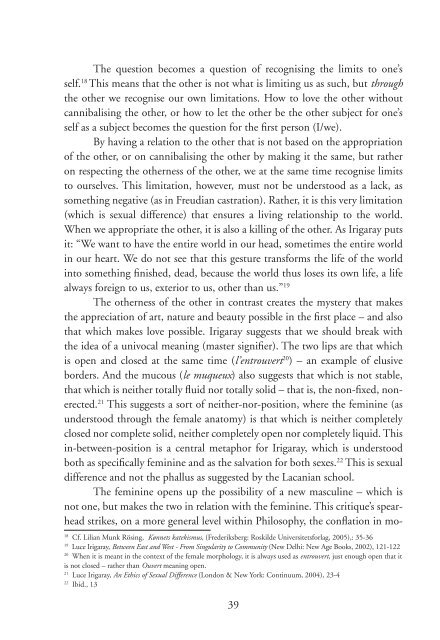Teaching Subjectivity. Travelling Selves for Feminist ... - MailChimp
Teaching Subjectivity. Travelling Selves for Feminist ... - MailChimp
Teaching Subjectivity. Travelling Selves for Feminist ... - MailChimp
You also want an ePaper? Increase the reach of your titles
YUMPU automatically turns print PDFs into web optimized ePapers that Google loves.
The question becomes a question of recognising the limits to one’s<br />
self. 18 This means that the other is not what is limiting us as such, but through<br />
the other we recognise our own limitations. How to love the other without<br />
cannibalising the other, or how to let the other be the other subject <strong>for</strong> one’s<br />
self as a subject becomes the question <strong>for</strong> the first person (I/we).<br />
By having a relation to the other that is not based on the appropriation<br />
of the other, or on cannibalising the other by making it the same, but rather<br />
on respecting the otherness of the other, we at the same time recognise limits<br />
to ourselves. This limitation, however, must not be understood as a lack, as<br />
something negative (as in Freudian castration). Rather, it is this very limitation<br />
(which is sexual difference) that ensures a living relationship to the world.<br />
When we appropriate the other, it is also a killing of the other. As Irigaray puts<br />
it: “We want to have the entire world in our head, sometimes the entire world<br />
in our heart. We do not see that this gesture trans<strong>for</strong>ms the life of the world<br />
into something finished, dead, because the world thus loses its own life, a life<br />
always <strong>for</strong>eign to us, exterior to us, other than us.” 19<br />
The otherness of the other in contrast creates the mystery that makes<br />
the appreciation of art, nature and beauty possible in the first place – and also<br />
that which makes love possible. Irigaray suggests that we should break with<br />
the idea of a univocal meaning (master signifier). The two lips are that which<br />
is open and closed at the same time (l’entrouvert 20 ) – an example of elusive<br />
borders. And the mucous (le muqueux) also suggests that which is not stable,<br />
that which is neither totally fluid nor totally solid – that is, the non-fixed, nonerected.<br />
21 This suggests a sort of neither-nor-position, where the feminine (as<br />
understood through the female anatomy) is that which is neither completely<br />
closed nor complete solid, neither completely open nor completely liquid. This<br />
in-between-position is a central metaphor <strong>for</strong> Irigaray, which is understood<br />
both as specifically feminine and as the salvation <strong>for</strong> both sexes. 22 This is sexual<br />
difference and not the phallus as suggested by the Lacanian school.<br />
The feminine opens up the possibility of a new masculine – which is<br />
not one, but makes the two in relation with the feminine. This critique’s spearhead<br />
strikes, on a more general level within Philosophy, the conflation in mo-<br />
18<br />
Cf. Lilian Munk Rösing, Kønnets katekismus, (Frederiksberg: Roskilde Universitets<strong>for</strong>lag, 2005),: 35-36<br />
19<br />
Luce Irigaray, Between East and West - From Singularity to Community (New Delhi: New Age Books, 2002), 121-122<br />
20<br />
When it is meant in the context of the female morphology, it is always used as entrouvert, just enough open that it<br />
is not closed – rather than Ouvert meaning open.<br />
21<br />
Luce Irigaray, An Ethics of Sexual Difference (London & New York: Continuum, 2004), 23-4<br />
22<br />
Ibid., 13<br />
39

















